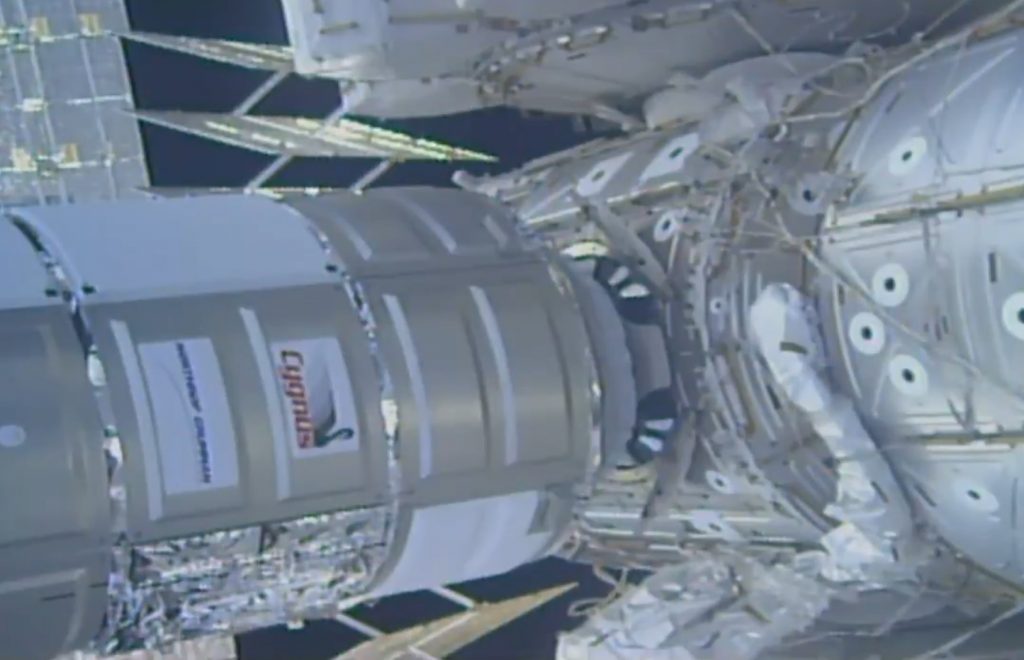
Thanks to a series of engineering marvels, we are one step closer today to doing something that has never been attempted before in space. As basic and as familiar as the task is on Earth, no one knows exactly what will happen in the micro-gravity environment of the International Space Station 254 miles above the Earth’s surface. Deliciousness is quite possible when this revolutionary experiment unfolds, though, as delicious as this space-based experient could be, we may not know just how sweet the results are for many more months.
Of course, the ground-breaking experiment we’re discussing is the astronauts’ first attempt at baking in an oven in space; their first subject will be none other than the chocolate chip cookie found at DoubleTree Hotels around the world.
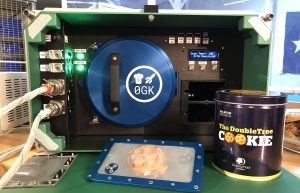
Early this morning, the Cygnus spacecraft docked to the International Space Station. It left Earth on Saturday morning, mounted to Northrop Grumman’s Antares rocket. The mission, known as NG-12, lifted from the Mid Atlantic spaceport at 9:59am, entertaining space-gazers from New York to North Carolina with a streak of light and a rumble of thunder as it leaped into space from the launch pad. Within the 8,200 pounds of cargo on the uncrewed Cygnus spacecraft is the Zero G Oven. Other contents include an incredible amount of science and supplies that will be consumed or used on-board the space station in the coming months. Astronauts Jessica Meir and Christina Koch captured the Cygnus resupply ship, named the S.S. Alan Bean after the Apollo and Skylab astronaut, at 4:10 am ET today with the Canadarm2 robotic arm. As the launch was on Saturday morning, the early-morning rendezvous with Cygnus was a complete success today.
Prior to today’s successful docking of Cygnus, things have been cooking for Ian and Jordana Fichtenbaum, the Co-Chefs behind the Zero G Oven. With the growth of the commercial space industry and plans to go to the Moon and Mars, they felt there was an unmet need in building household appliances for the space station at low cost. Through their innovation, the concept behind the Zero G Kitchen was born and the Zero G Oven was made.
The cylindrical oven was built at the NanoRacks facility in Webster, Texas, in collaboration with Zero G Kitchen. NanoRacks, an XO Markets company, is the world’s first commercial space station company that partners with many to utilize space and drive innovation through in-space manufacturing of pharmaceuticals, fiber optics, and now, chocolate chip cookies. Ultimately, NanoRacks hopes by bringing experiments to life on the International Space Station and beyond, transformational Earth observation will occur and the solutions to many of Earth’s problems will be discovered.
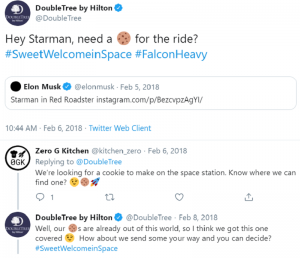
On February 6, 2018, SpaceX made history with the launch of their Falcon Heavy rocket, currently the most powerful rocket in the world. While capturing the attention of people around the world for the launch, many were captivated by the test cargo on-board the demonstration flight. While many inaugural rocket launches are loaded with a block of concrete to minimize loss should something go wrong with the initial flight, SpaceX’s Elon Musk opted to put his Tesla Roadster into space. Musk made the unconventional cargo even more unconventional by putting a mannequin in the driver’s seat, outfitted with a SpaceX spacesuit it developed for its owned manned missions into space.
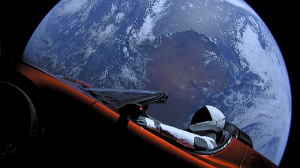
Nicknamed Starman, DoubleTree Tweeted to Elon Musk if the mannequin would like a chocolate chip cookie. Zero G Kitchen saw the Tweet and replied, saying they were looking for a cookie partner. The random social media interaction was the recipe for success of this cookie experiment.
Garrett Marqua, a Senior Director of Brand Management for the DoubleTree by Hilton brand, provided us some background of their cookie history. “We turn 50 this year,” Garrett started, describing the brand history at NASA Wallops the day before launch. “The brand was founded in 1969. Originally, the cookie came into conception as a symbol of hospitality when people arrived at our hotel. The cookie was introduced in 1986 and was introduced as part of the turn-down service then. It then caught-on and became so synonymous with the brand that we decided to move the cookie to being introduced to the guest when they checked-in the hotel, which occured in 1995.”
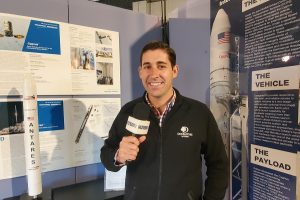
DoubleTree was acquired by Hilton in 2009 and has exploded in size around the world since. “We were in one country, and now we’re in 46, with plans to grow even larger,” added Marqua.
The signature cookie is the same around the world. While different suppliers local to the geographies they serve whip up the cookies for their region around the globe, they all follow a universal recipe. Those suppliers send the cookie dough to the hotel as frozen “pucks” where they’re baked fresh. “When you receive a cookie at check-in at DoubleTree hotels, they’re baked on-site every morning,” spoke Marqua proud of his chain’s sweet treat.
“We’re so excited with this experiment because the cookie dough going into space is the same exact cookie dough you receive if you were at a hotel. It hasn’t been modified or anything.”
While the Zero G Oven arrived via Cygnus today, the raw cookie dough was shipped to the International Space Station on an uncrewed Dragon cargo craft on a SpaceX rocket in July. Delivered via SpaceX’s CRS-18 mission, which launched from Space Launch Complex 40 at Cape Canaveral Air Force Station in Florida on July 25, 2019, within the 5,000 pounds of supplies, equipment and material for use by ISS astronauts were 5 pucks of frozen cookie dough. They’ve remained frozen ever since on the ISS.
In the days and weeks ahead, based on NASA crew schedules, astronauts will get cooking. Once the Zero G Oven is installed in NanoRacks’ Frame 3, currently located in the Japanese Experiment Module (Kibo) of the International Space Station, the great baking experiment will commence. Three of the 5 pucks will be baked; the remaining 2 are to be used at the astronaut’s discretion. The three baked cookies will return to Earth on a future SpaceX mission. No one is quite sure what will happen next.
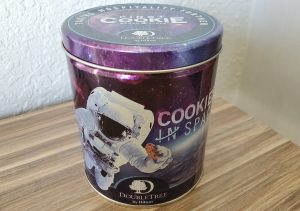
On Earth, as simple as baking seems, it is quite the complicated scientific process. On Earth, when butter and sugar are creamed, air is combined into the mix, creating a fluffier substance. The jagged crystals found in sugar cut air into the butter, forming a buttery layer around microscopic air pockets. The more of these pockets exist, the fluffier the baked product will be. Generally, when eggs are added to a creamed sugar mixture, the proteins found in the egg usually protect those buttery bubbles, ultimately leading to a flaky cookie, cake, or crust when heat is added. Even the way something looks out of the oven is the result of a chemical process. Known as the Maillard Reaction, sugars and amino acids in dough and batters break down to form robust flavor compounds that are only possible through the baking process. In addition to flavor, this chemical reaction also gives things we bake their unique golden brown color.
The great tasting, great-looking treats people bake here on Earth also have one thing in common: gravity is present. But in a near-zero gravity environment like what’s found on the ISS, no one is sure how these processes will unfold, or if they will at all, when a chocolate chip cookie is attempted to be baked.
During a pre-launch science briefing, Mary Murphy, Senior Internal Payloads Manager at NanoRacks for the Zero G Kitchen, gave an honest assessment how she thinks the baked cookies will come out: she doesn’t know. “Because the cookie won’t be baking with gravity against a cookie sheet as it would on Earth, it could turn out to be cylindrical or even spherical,” Murphy told reporters. It’s also unknown how the chemical processes that produce a delicious cookie on Earth will work in space with limited gravity.
Marqua is looking forward to seeing what happens. “In terms of the experiment, we’re not concerned; it’s just an experiment. We think that the results will be great and will hopefully taste great. And it should taste great if someone chooses to indulge in one or two of the cookies not coming back to Earth.”
Once back on Earth, NASA will begin testing of the cookies to confirm what happened during the baking experience and to determine if they’re edible or not.
Did you love today’s @northropgrumman launch of their #Antares rocket bringing #Cygnus to the @ISS_CASIS? We did! And we all get to do it all over again in a few months. Next tentative launch is in February 2020! #NG12 #NG13https://t.co/jzefRUaGUw
— the Weatherboy (@theWeatherboy) November 3, 2019
Before that happens though, astronauts will need to see how the oven actually works. The 4.2″ x 8.8″ oven offers a total interior volume of 122 cubic inches, quite small by Earth kitchen standards. Since convection is not possible or difficult in zero gravity, heating is accomplished through electric heating elements powered by electricity drawn from the International Space Station’s internal power system. Heating elements are placed in a way to create a “pocket of heat” within the oven. Beyond the unusual oven comes unusual cooking tools. Because they don’t want cookies to float in or away from the oven, the dough is placed inside a flexible silicone pouch providing space chefs with a clear view of what’s cooking inside. There are two 40-micron filters in the silicone sheets to allow steam and hot air to escape, but to also prevent cookie crumbs from escaping and potentially damaging filters or sensitive equipment on the ISS.

This will be the first time astronauts cook in space. Most food astronauts eat are dehydrated, requiring the addition of hot water to become Earth-food-like. Other food pouches can also be heated up, although the existing “oven” on-board the ISS can only warm to 180 degrees F. Never before has an attempt been made in space of actually cooking or baking food but the lessons learned from this cookie experiment could pave the way for future cooking and eating experiments that could open up a whole new way for astronauts to make and consume food for future ISS missions and missions to the Moon and Mars and beyond.
Marqua hopes more than a delicious cookie will bake in space; he hopes the symbolism of hospitality will evoke positive emotions not only for his brand, but for those on ISS and those watching from Earth. “The cookie is very meaningful… It’s supposed to instill a feeling; not just a satisfying feeling in your belly, but also a feeling of warmth and comfortability. We hope when guests check into our hotel and eat our cookie, it reminds them of something that brings happiness to them, like baking cookies with their family, or another good memory they have.” Marqua added, “We’re very humbled to be a part of this because this is more than just a cookie. To be bringing something which symbolizes hospitality in space and to be the very first hospitality company to experiment in outer space is very exciting for us.”